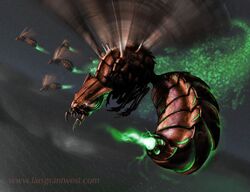Wirefly
| Wirefly | |
|---|---|
 Illu. Lars Grant-West | |
| Creature Type | |
| (Subtype for creature/kindred cards) | |
| Introduced | Darksteel |
| Last used | Obsolete |
| Updated to | Insect |
Wirefly is an obsolete creature type for cards that represented a type of artificial flying insect from Mirrodin.
History
Wirefly debuted as a creature type in Darksteel on tokens created by Wirefly Hive. It had an activated ability for to create a 2/2 Wirefly artifact creature with flying if a coin flip was won, otherwise all Wireflies would be destroyed. During the Grand Creature Type Update, the type was made obsolete with Wirefly Hive being errataed to instead create insect tokens named Wirefly.[1]
During this period, Wizards of the Coast rarely made printed tokens for boosters but needed art for unique tokens displayed on Magic Online. The MTGO token shows that Wireflies emit a green gas or plasma from a port or orifice positioned at the end of their abdomen, where a wasp's stinger would be.
Description
Wireflies appear to be a race of artificial bees or wasps that lived in hives on Mirrodin before it became New Phyrexia. It is unknown if they exist in any form following the plane's conversion or if they are now extinct. Bruenna, leader of the Neurok, once described their lifespan as "short".[2]
Gallery
-
Wirefly Hive art
-
Magic Online token art
In-game references
- Represented in:
References
- ↑ Mark Gottlieb (September 26, 2007). "The Grand Creature Type Update". magicthegathering.com. Wizards of the Coast. Archived from the original on May 3, 2021.
- ↑ Flavor text of Wirefly Hive (Darksteel).

